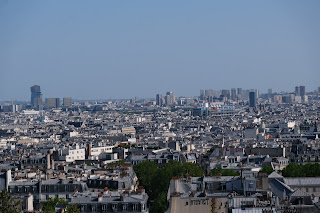Have I gone off my rocker with the above tagline? How could a place with nearly 2.2 million people be a small town? Note small towns plural.
 |
| City sprawl from a quiet spot in Montmarte |
Numerous European cities differ from those in North America by not being entirely geared to automobiles. There are indeed traffic-clogged streets filled with the brash claxon peals of car horns in Paris, but much of the city consists of neighborhoods in which feet and bicycles are ubiquitous. It’s huge in area, but its neighborhoods function as villages within the metropolis, each with a distinct character.
 |
| Bikes outside a major train station |
Paris is divided into 17 districts–it used to be 20–called arrondisements. These go back to times in which most were separate villages and towns. By my count I’ve been to a dozen during my four visits, enough to offer a generalization: Paris is more human-scaled than most US cities.
| Off Blvd St-Michel |
Think of places such as Atlanta, Dallas, Los Angeles, or Phoenix whose sprawl is so vast and generic that there is “no there there,” as Gertrude Stein famously observed about Oakland. Scores of others have spawned cookie-cutter suburbs and distant exurbs. In each case, public life and community identity are truncated or non-existent.
Only a handful of U.S. and Canadian cities come close to offering a comparable intimate vibe to Paris. New York perhaps, though many of its boroughs are services-challenged. Parts of Montreal, Portland, San Francisco and Vancouver also spring to mind, but even they have numerous isolated neighborhoods in which stores and entertainment are distant from where the populace resides. Boston is walkable, but its traffic snarl is infamous for a reason; there’s just not much going on in most of the ‘burbs and several of its inner-city neighborhoods lack amenities.
Good public transportation is rare in North American cities, though it’s not a panacea if it does exist. It takes urbanities from one place to the next–and subways are far faster than surface traffic–but it mostly moves people when they must leave where they live. That’s usually connected to work, whether we define that as where paychecks are doled out, or gathering food and other necessities. In such a setup, going to a café, seeing a movie, meeting friends, or even taking a walk becomes a “task.” That’s why so many people endlessly complain of lacking leisure time.
 |
| Vaneau cafe after hours |
In June, we stayed in Vaneau, which straddles Paris’ 6th and 7th arrondisements. You’ve probably never heard of this quiet residential neighborhood, but it also had a nice hotel and, as my first evening’s stroll revealed, numerous green grocers, two patisseries, several cafés, and a smelly store that proved to be a fromagerie. Within two blocks was a Bon Marché department store and a side street with numerous shops. That small street ended at large café, a new district, and the Vaneau pattern repeated. Hop on the Metro you’ll see the same elsewhere, though each neighborhood exudes its own vibe. When we went to the 9th arrondisement for dinner, it was grittier than Vaneau but also quite vibrant.
 |
| In the 9th arrondisement |
Paris was drastically rebuilt and modernized by Baron Haussmann in the mid-19th century. He cleaned out dangerous areas and gave it the Renaissance Revival elegance with which we today associate the city. What did not happen next is just as important: Paris did not throw its neighborhoods under automobile tires. It could have happened. Carl Benz, a German, gets credit for the first automobile in 1886, but French inventors came up with prototypes a century earlier.
 |
| Even bike racks look good amidst this |
Many U.S. cities used to be like Paris. In 1908, though, Henry Ford’s Model-T rolled out of his factory and altered the course of American history. Automobiles were instrumental in creating distinct shopping and entertainment precincts: first downtowns, then further-distanced shopping centers and venues, then suburbia. Trolley lines and railroads went into deep decline and cross-street traffic made walking more difficult. Car culture trifurcates where we live, work, and play. They’re also a time suck. A London study revealed Victorians moved faster in horse-drawn carriages.
 |
| Tourist area, but note who rules the streets |
One of my Northampton friends is French, spent his youth in Paris, and tries new neighborhoods when he visits. He doesn’t rent a car, but he is yet to come back saying there was nothing to see, do, or eat where he’s stayed. Surface traffic in Paris can be as brutal as in any American city, but let’s hear it for cities as a collection of towns rather than a network of asphalt.
Rob Weir




No comments:
Post a Comment